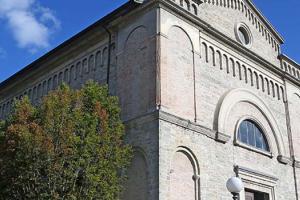Santa Sofia
Primary tabs
Santa Sofia
A door to the past. The place where Tuscany and Romagna meet along the banks of the River Bidente between the streets lined with ancient palaces and small temples in which contemporary art reigns, reinforce the ancient relationships of friendship and division between Santa Sofia and Mortano, respectively placed on the left and right bank of the river.
Santa Sofia is found in the green Apennine hills, in the heart of the Foreste Casentinesi National Park. An Ancient frontier land that is now recognised as a "City of Good Life" for the quality of its gastronomic products, for artistic vivacity and for the search for a harmonious and compatible lifestyle. Its slow pace and the friendliness of its people make it a "slow city".
There were settlements as early as prehistoric times, as evidenced by the finds from the Neolithic period, it’s history is linked to the River Bidente, which cuts the city in two and has made two distinct centres, one under the influence of the Papal State and the other under the Grand Duchy of Tuscany , until reunification took place in 1923.
The footprint of the Medici's domination is breathtaking along the perimeter of the main square, Piazza Matteotti, overlooking the Bidente. The buildings of 1500 and 1600, all reconstructed after the earthquake of 1918, contribute to the "Piccola Firenze": the civic tower, the municipal building (formerly Crisolini Malatesta), the oratory of the Most Holy Crucified (or the Gonfalone), commissioned by the Giorni family, and Palazzo Giorgi, with its late baroque façade and the garden on the back became a public park, built by the Mortani family and now home to a credit institution.
The range of natural disasters, which have made the territory unstable and provisional are transpired in the canvas preserved in the parish church of Santa Lucia, painted by an anonymous painter from the 1600’s, in which the deep transformations of the main square are documented due to seismic events . The opposite portion of the territory that develops to the right of the Bidente is a small treasure chest of contemporary art treasures.
In Via Roma there is the contemporary art gallery "Vero Stoppioni", with a permanent collection of movements of various trends and works collected from the mid-twentieth century to today and during the various editions of the prestigious Art Campaign Award. The Mistura, a splendid work by Mattia Moreni, and other works such as the self-portrait series, stand out. The open-air river-park, connected to the gallery, exhibits at different points in the city environmental installations of world-renowned artists, such as the Poirers, creating a unique blend of art and natural and urban ambience.
In addition to the artistic treasures, Santa Sofia is rich in natural beauty: the Campigna forest, for example, with its white fir trees and green paths, has wonderful views in every season. Those who arrive in the summer are enchanted by the vibrancy of cultural festivals, such as the Buskers festival, a traditional appointment with street artists from all over the world.
The typical "tortello" filled with pumpkin and potatoes, once cooked on rough sandstone slabs, today is celebrated in the renowned festival in mid-October.
The medieval hamlet of Corniolo nearby is worth visiting, a former feud of the Conti Guidi, rich in tourist facilities and architectural treasures such as the church of San Pietro from the 12th century, Sao Paolo in Alpe, an ancient abandoned peasant village, and finally Ridracoli with its old restored farmhouses, dam and artificial lake.










